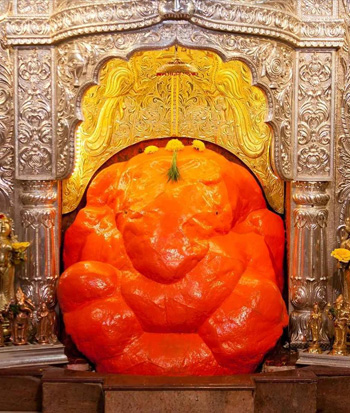Shri Mahaganapati – Ranjangaon
The main temple here, built by Madhavrao Peshwa, is dedicated to Maha Ganapati.
Air : The nearest Airport is Pune (90 Km).
Rail : The nearest rail head is Urali (16 Km) on Pune-Daund section.
Road : Ranjangaon is well connected by road. It is 223 Km from Mumbai. State Transport buses ply from Pune and Ahmednagar to Ranjangaon.
Religious Importance
Shiva is believed to have worshipped Ganesha before fighting the demon Tripurasura here. The temple was built by Shiva where he worshipped Ganesha, and the town he set up was called Manipur which is now known as Ranjangaon.
Ranjangaon Ganpati is one among the Ashtavinayak, celebrating eight instances of legends related to Ganesha. This Temple Ganpati Idol was inaugurated and donated by “Khollam” Family one of the Gold Smith Family in Ranjangaon. According to the history the temple was built in between 9th and 10th century.
While going from the Pune – Nagar highway the route is Pune – Koregaon – then via Shikrapur; Rajangaon is 21 km before Shirur. From Pune it is 50 km.
The idol faces the east, is seated in a cross-legged position with a broad forehead, with its trunk pointing to the left. It is said that the original idol is hidden in the basement, having 10 trunks and 20 hands and is called Mahotkat, however, the temple authorities deny existence of any such idol.
Constructed so that the rays of the sun fall directly on the idol (during the Southward movement of the sun), the temple bears a distinct resemblance to the architecture reminiscent of the 9th and 10th Centuries and faces the east. Shrimant Madhavrao Peshwa used to visit this temple very often and built the stone sanctum around the idol and in 1790 AD Mr. Anyaba Dev was authorised to worship the idol.
The Temple: Mahaganapati is portrayed, seated on a lotus, flanked by his consorts Siddhi and Ridhi. The temple dates back to the period of Peshwa Madhav Rao.
The temple of Maha Ganpati is very close to the centre of the town Ranjangaon. The temple was erected during the rule of the Peshwas. Peshwa Madhavrao had constructed the inner sanctum, to house the swayambhoo (naturally found) idol.
.

